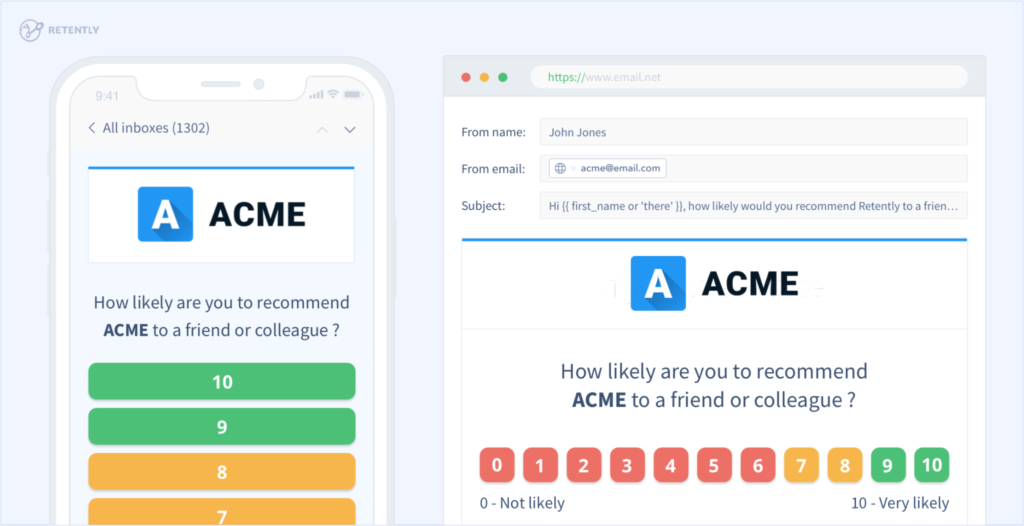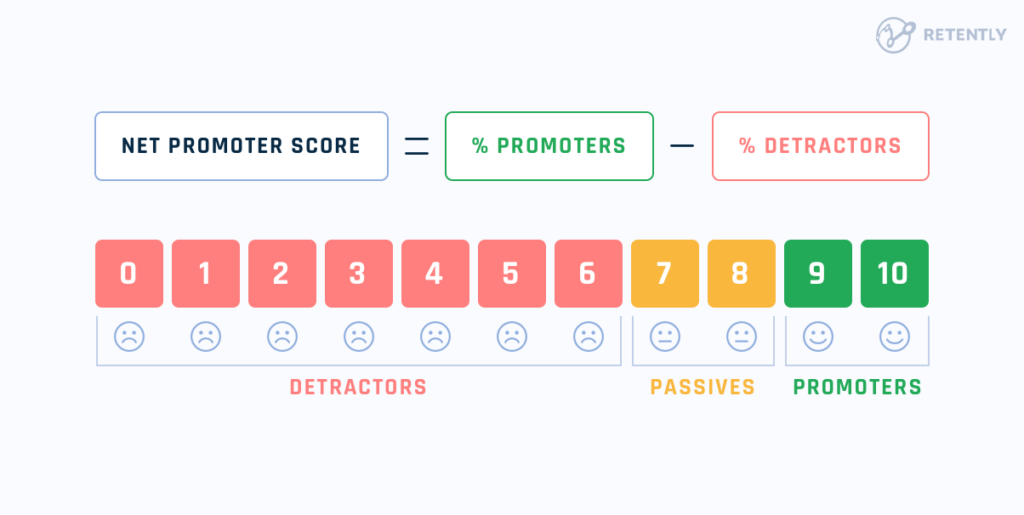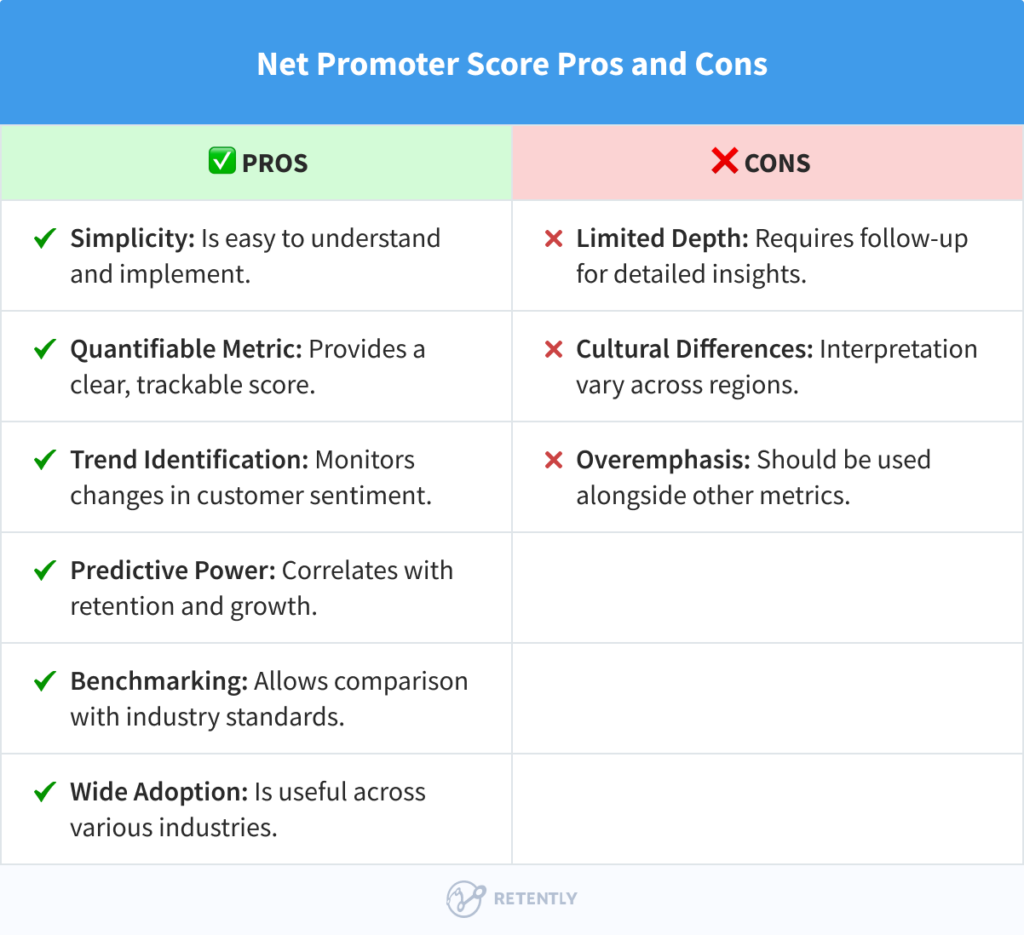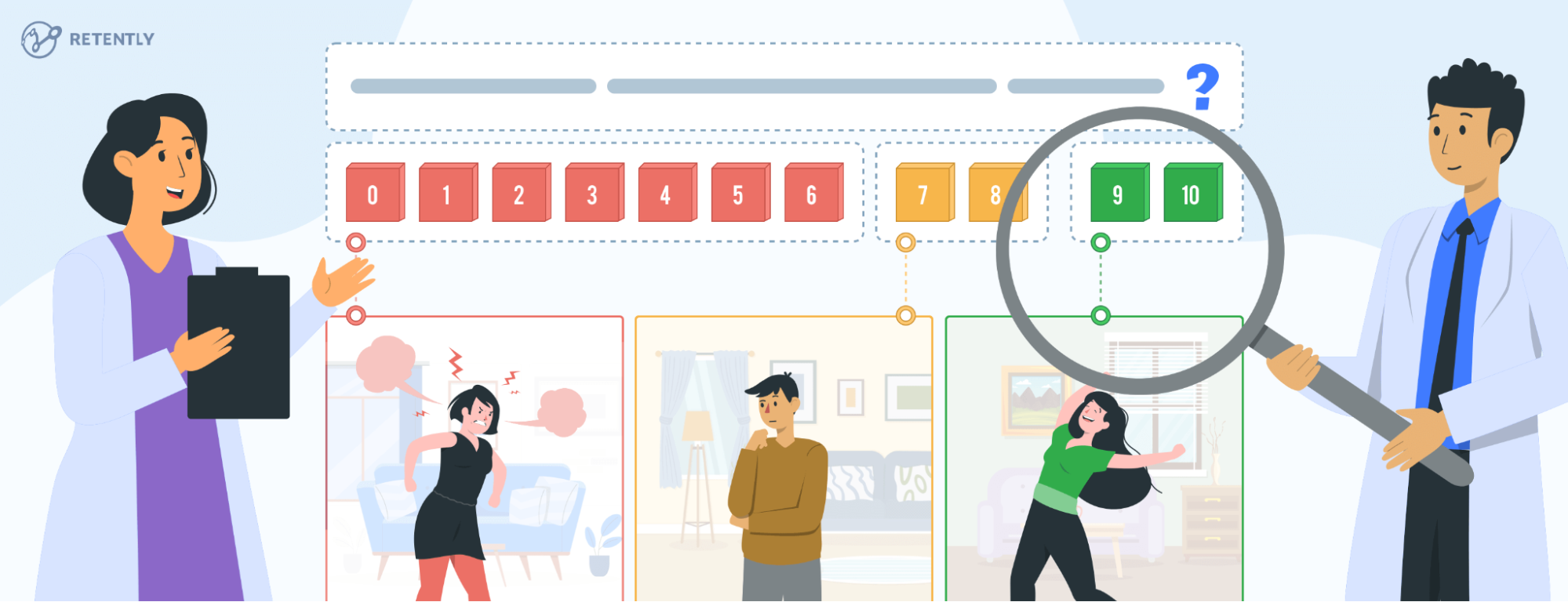Table of Contents
Imagine a tool so powerful yet simple that it can transform your understanding of customer loyalty with just one question. This tool not only identifies your most passionate supporters but also uncovers your biggest critics. It’s like having a direct line to your customers, allowing you to tap into their true feelings about your brand.
What if you could easily measure how likely your customers are to recommend your business to others? This insight could guide your strategies, boost your customer service, and ultimately drive growth. That’s the power of the Net Promoter Score (NPS).
In this article, we’ll explore the ins and outs of NPS: starting with what is NPS and its origin to why it matters for your business, and how you can use it to improve customer relationships and drive growth.
Let’s dive in.
Key Takeaways
- Net Promoter Score offers a straightforward way to measure customer satisfaction and loyalty by asking a single question about the likelihood of recommending your product or service.
- NPS isn’t just about collecting scores. Analyzing and acting on the feedback from Promoters, Passives, and Detractors can help you identify strengths, address weaknesses, and continuously improve customer experiences.
- With its easy-to-understand question and calculation method, NPS is accessible to businesses of all sizes. It allows for regular tracking of customer sentiment and benchmarking against industry standards.
Understanding NPS
Let’s start by breaking down the basics of the Net Promoter Score:
What is NPS?
So, what exactly is NPS? Net Promoter Score is a widely-used customer loyalty metric that helps businesses understand how their customers feel about their product or service. Simply put, it’s a score that shows how likely customers are to recommend a company, product, or service to others.
The goal is to find out who your biggest fans are and who might be less thrilled with what you’re offering. This insight helps identify areas of strength and those needing improvement, in order to make strategic changes that boost customer satisfaction and growth.
The Story Behind NPS
In 2003, Fred Reichheld of Bain & Company introduced the business world to a game-changing idea. He proposed a simple way to measure customer loyalty with just one question. His article in the Harvard Business Review, “The One Number You Need to Grow“, highlighted the flaws in traditional customer satisfaction surveys, which were often too complicated and missed the mark in capturing true customer happiness.
Thus, the NPS concept traces back to an ambitious research project that studied 400 American companies to see which question could best predict customer loyalty. They discovered that asking customers about their likelihood to recommend a service or product was the most effective measure across industries. This laid the groundwork for what we now know as the NPS framework.
Fast-forward to 2024, and the numbers speak for themselves: industries leading in NPS see an average revenue growth 2.5 times higher than others and enjoy 10% better customer retention rates.
How NPS Works: The NPS Methodology
NPS strips away the complexity of traditional surveys and focuses on what truly matters: understanding your customers’ loyalty and using that knowledge to grow your business. It all boils down to:
1. The NPS Question
At the heart of NPS is a single, straightforward question:
“How likely are you to recommend our company/product/service to a friend or colleague?”
Customers answer this question on a scale of 0 to 10, where 0 means “not at all likely” and 10 means “extremely likely.”
This question cuts to the core of customer satisfaction and loyalty. It’s not just about whether customers like your product or service; it’s about whether they believe in it enough to tell their friends and family.

Yet, while many think of Net Promoter Score as orbiting around a simple 0 to 10 NPS scale, there are actually two sides to it — the rating question (quantitative data) and the open-ended question (qualitative insights).
The follow-up question, such as “What is the primary reason for your score?” attaches context to the rating. These questions pack a punch by capturing the overall customer sentiment in a way that’s easy to quantify and analyze.
2. Categorizing Respondents
Once you’ve asked these all-important questions, the next step is to categorize the responses. Based on their answers, customers are grouped into three categories:
Promoters (9-10): Brand Advocates
- Who they are: Promoters are your most passionate supporters, rating you a 9 or 10. They love your product or service and actively share their positive experiences with others through social media, product reviews, or casual conversations.
- Why they matter: These loyal clients not only make repeat purchases but also help attract new customers with their enthusiastic endorsements, driving growth through word-of-mouth marketing.
Passives (7-8): Quietly Content Users
- Who they are: Passives score you a 7 or 8. They are generally satisfied enough to keep using your product but not impressed enough to recommend it.
- Why they matter: While they’re not likely to spread negative feedback, they’re also not going to actively promote your brand. Their neutrality can be risky if a competitor offers something more appealing. Engaging and turning them into Promoters is essential for maintaining a strong customer base.
Detractors (0-6): Dissatisfied Patrons
- Who they are: Detractors are unhappy customers who rate you between 0 and 6. They might have had a bad experience or feel that your product or service doesn’t meet their needs. These customers might actively discourage others from using your products or services and are unlikely to make another purchase.
- Why they matter: Detractors can harm your reputation through bad reviews and negative word-of-mouth. Their feedback is key because it highlights areas for improvement. Understanding and addressing their concerns can win them over or at least minimize the impact of their complaints.
By understanding these categories, you can start to see the bigger picture of how your customers feel about your business. Promoters are your allies in growth, Passives are an opportunity for improvement, and Detractors are a wake-up call for necessary changes. This simple categorization helps you focus your efforts where they’ll have the most impact.
3. How to Calculate Your NPS Score
Once you’ve gathered your survey responses, it’s time to calculate your NPS score. Here’s a quick refresher on the NPS formula:
NPS = (%PROMOTERS − %DETRACTORS)
The overall NPS is calculated by subtracting the percentage of Detractors from the percentage of Promoters, resulting in a score ranging from -100 to 100.
Passives are counted but not included in the final NPS calculation. They do, however, provide valuable insights into areas that need improvement.

Calculation Example
Let’s review an example with 100 respondents to see how the calculation works:
- Promoters: 50 respondents (50%)
- Passives: 30 respondents (30%)
- Detractors: 20 respondents (20%)
- Calculation: NPS = 50% – 20% = 30
Result: An NPS of 30 indicates a healthy level of customer satisfaction with room for improvement.
The higher the NPS, the better your customer satisfaction and loyalty. Companies with high NPS scores typically enjoy strong customer loyalty and positive word-of-mouth.
Interpreting NPS Results
Understanding what makes a good NPS score can be a bit tricky. A score of 30 might be fantastic in one industry but just okay in another. Benchmarking your score against industry standards can provide additional context.
Generally speaking, if your score is below 0, it means you have more unhappy customers than happy ones, signaling significant issues that need immediate attention. A score above 0 is a good sign – it means you have more Promoters than Detractors. However, it’s important to keep pushing for a higher score each time, showing that you’re continuously improving and committed to customer success.
By regularly calculating and monitoring your NPS, you can track how customer sentiment changes over time and identify areas for improvement to boost loyalty and satisfaction.
Keep in mind that these scores are averages. Your NPS performance can be influenced by several factors like customer tolerance level, competition or global events. Read our guide exploring what is a good Net Promoter Score, NPS benchmarks by industry and more for insightful ideas.
Why NPS Matters: Benefits of Using the Metric
Integrating NPS into your feedback strategies provides valuable insights that drive your business forward.
Here’s why NPS is a game-changer for businesses:
- Predicts Business Growth: Research shows that businesses with long-term profitable growth have NPS scores twice the average. Thus, Net Promoter System leaders grow over twice as fast as their competitors, highlighting the significant impact of customer satisfaction on business expansion.
- Boosts Customer Retention: Retaining existing customers costs five to ten times less than acquiring new ones and they spend about 67% more. NPS helps improve customer satisfaction, which in turn increases customer lifetime value and boosts revenue. Thus, effective retention strategies informed by NPS can significantly improve your business trajectory.
- Simplifies Feedback: NPS makes it easy for customers to give feedback and for businesses to act on it quickly. With just one question, you get valuable insights that are easy to understand and use. This means that even small businesses with limited resources can effectively use NPS to gauge customer satisfaction and loyalty. Plus, because the concept is easy to grasp, it’s easier to get buy-in from all levels of the organization, from frontline employees to top executives.
- Benchmarks Success: NPS allows for comparative benchmarking across industries. The standardized NPS question lets companies measure up against the top players in their industry and beyond, as it’s used by over two-thirds of Fortune 1000 companies. Internally, NPS can be used to compare different departments, products, or services within your own organization, helping identify best practices and areas for improvement across the board.
- Encourages Customer-Centric Improvements: NPS helps pinpoint areas for improvement based on customer feedback. This ensures you are always making changes that benefit your customers. The continuous feedback loop keeps your business aligned with customer needs and expectations.
- Drives Referrals: NPS encourages customer referrals and positive word-of-mouth by identifying your most enthusiastic customers. Promoters share their positive experiences, driving organic growth. Since 88% of people trust recommendations from friends and family more than any advertising, this significantly improves your bottom lines.
- Measures Employee Sentiment: NPS isn’t just for customers. You can use eNPS to gauge how happy and engaged your employees are, too. Happy employees lead to happy customers, creating a positive feedback loop that benefits your entire business.
How to Collect NPS Data
NPS is an extremely useful methodology; the trick is when and how to use it to get the most out of it. It’s about how to generate actionable data and transpose it into a viable customer-centered strategy. Here’s a straightforward way to get started:
Designing Your NPS Survey
Designing an effective NPS survey involves more than just asking the right questions; it’s about creating a user-friendly experience that encourages participation and provides actionable insights.
Start by keeping your survey short and straightforward. Limit the number of questions to avoid overwhelming respondents, and ensure that each question is clear and relevant.
The core NPS rating question should be complemented with one or two open-ended questions to gather qualitative feedback. This qualitative feedback provides deeper insights into the reasons behind their scores and helps identify specific areas for improvement. Check out our templates for NPS survey questions and responses for specific ideas.
Personalizing the survey by addressing the customer by name and referencing specific interactions can also increase engagement and provide more accurate feedback. Additionally, always ensure your surveys are mobile-friendly to cater to on-the-go responses.
When and How Often to Measure NPS
Sending too many surveys can tire out your customers, leading to lower response rates and less reliable data. To avoid survey fatigue, be strategic about when and how often you measure NPS. Make sure surveys are timed right and relevant to customer interactions. Here are some key pointers to keep in mind:
- Periodic or at Regular Intervals: Conduct surveys at regular intervals, such as quarterly, biannually, or yearly. This approach helps you track shifts in customer sentiment over time and measure the impact of any changes you’ve implemented. Also known as relational NPS, the focus is on providing a broad view of the customer relationship.
- After Key Milestones: This approach is also referred to as transactional NPS and focuses on significant events or specific interactions to provide targeted insights. These touchpoints will differ between B2B and B2C settings. For example, as a SaaS software you could send an NPS survey after launching a new feature, at the end of a trial period, or as exit survey.
Explore more on the differences between these NPS campaigns in our dedicated article.
Also, make sure to get feedback from a broad mix of customers to avoid bias and get a balanced view. To maximize your reach, use multiple survey channels such as email, SMS, in-app notifications, and website pop-ups. Offering small incentives can help boost participation too.
Turning NPS Feedback into Action
Collecting NPS feedback is just the first step; the real value lies in how you act on it. This proactive approach not only builds trust and loyalty but also transforms insights into tangible results for your business.
Here’s how to use your NPS insights to drive improvements:
1. Reach Out to Detractors
Address the concerns of unhappy customers promptly to show them that their feedback matters. Contact Detractors personally to understand their issues and work on specific solutions. For example, if a customer is unhappy with your customer service, provide them with a direct contact for a dedicated support representative. This personal touch can transform dissatisfied customers into loyal ones, as they feel heard and valued. A proactive approach in resolving issues helps close the feedback loop and shows your commitment to improvement.
2. Celebrate and Leverage Promoters
NPS helps identify Promoters, your most loyal customers who are likely to recommend your brand. Engage with Promoters by thanking them personally and asking for testimonials or case studies. Encourage them to share their positive experiences on social media or review platforms by providing easy-to-use links and templates. Genuine recommendations from happy customers can attract new clients and expand your customer base. Celebrate their loyalty by offering them exclusive discounts or early access to new products, strengthening your bond.
3. Address Passives
Convert Passives into Promoters by improving the aspects of your product or service that didn’t fully meet their expectations. Analyze their feedback to identify common areas for improvement. For instance, if Passives mention slow delivery times, work on optimizing your logistics to speed up the process. Personalized follow-ups, such as a thank-you note with a special offer or a discount on their next purchase, can make a big difference in boosting their satisfaction and turning them into enthusiastic Promoters.
4. Guide Strategic Planning
Use NPS data to guide your broader business strategy. Identify patterns in feedback to pinpoint specific features or services that need improvement. For instance, if a specific feature consistently receives negative feedback, prioritize its improvement in your product roadmap. Focus on quick wins that can immediately enhance customer satisfaction, as well as long-term improvements that address systemic issues. Review NPS feedback regularly in team meetings to ensure that all departments are aligned with customer needs.
5. Reinforce Input Value
Keep customers informed about how their feedback leads to tangible improvements. Share updates through newsletters, social media, or a dedicated section on your website showcasing changes made based on customer input. This transparency builds trust and enhances loyalty, turning everyday users into enthusiastic advocates for your brand. By consistently addressing feedback and clearly communicating changes you ensure that NPS is instrumental for both quick fixes and long-term growth.
Ultimately, NPS is more than just a number; it’s a powerful tool for building stronger relationships with your customers and ensuring your business thrives.
Weighing the Advantages and Disadvantages of NPS
In the quest to quantify customer loyalty and satisfaction, few tools are as widely adopted as the Net Promoter Score. However, it is important to understand both its benefits and limitations. Here’s a breakdown of the advantages and challenges of using NPS:
NPS Pros
NPS stands out for its simplicity and ease of use. With just a single question, businesses can quickly gauge customer loyalty without delving into complex data analysis. Anyone can grasp what the score means and how to use it to make improvements. Plus, because it’s just one question, it’s not a burden on your customers, making them more likely to respond.
NPS provides a clear and quantifiable metric that can track changes over time. By regularly measuring NPS, you can see trends in customer loyalty and satisfaction. This makes it easy to monitor improvements or identify areas that need attention. It’s a great way to keep your finger on the pulse of your customer base and ensure you’re moving in the right direction.
NPS also facilitates benchmarking, allowing companies to compare their scores with industry standards and competitors. This provides valuable context for performance evaluation and helps set realistic improvement goals. Internally, NPS can be used to compare different products, services, or departments, highlighting strengths and weaknesses across the organization.
The actionable insights from NPS surveys are another major benefit. The follow-up questions provide qualitative data that helps identify specific areas for improvement, prioritizing critical issues that impact customer satisfaction. High NPS scores correlate with higher customer retention rates and can drive new customer acquisition through positive word-of-mouth from Promoters.

NPS Cons
Despite its advantages, NPS has its limitations. The single-question format may not capture the full complexity of customer experiences and issues, leading to a lack of depth in feedback. This can result in missed nuances that are important for a comprehensive understanding of customer sentiment.
Response bias is a significant concern. Customers with very strong positive or negative feelings are more likely to respond, potentially skewing the data. Satisfied but not enthusiastic customers (Passives) might not bother to answer, leading to an incomplete picture of overall customer sentiment. Additionally, to get a truly accurate picture, you need a large sample size. Small samples can lead to misleading results, making it harder to draw reliable conclusions.
Cultural differences can also impact how customers interpret the rating scale, affecting the accuracy of the score. Businesses may need to adjust their interpretation of scores based on cultural norms and expectations to get a more accurate understanding of customer sentiment.
NPS is great for gauging customer loyalty and satisfaction, but don’t rely on it alone. While it provides valuable insights, it doesn’t tell the whole story. To get a complete picture, use NPS along with other customer satisfaction metrics like Customer Satisfaction Score (CSAT) and Customer Effort Score (CES). This way, you’re looking at all angles of the customer experience and making better decisions.
Bottom Line: Ask, Measure and Act
Alright, let’s wrap things up! We’ve covered a lot about the Net Promoter Score and why it’s such a valuable tool for any business across both B2B and B2C industries. This clear-cut method allows businesses to keep a pulse on customer sentiment. The main goal? Increase the number of Promoters – enthusiasts likely to attract new clients through positive word-of-mouth – while minimizing Detractors, who could potentially harm your brand’s reputation.
If you haven’t already, now is the perfect time to start measuring your NPS. Begin by implementing NPS surveys at regular intervals or key milestones in your customer journey. But don’t just measure – act on your NPS data. Whether it’s enhancing customer service, refining your products, or streamlining processes, acting on NPS insights can drive significant business growth and improved customer satisfaction.
While managing and analyzing NPS data can be complex and resource-intensive, Retently has got you covered. Our comprehensive CX solutions simplify the entire process, providing actionable insights without the hassle.
Ready to boost your customer loyalty? Start with a free trial and let Retently handle your NPS needs.



































 Greg Raileanu
Greg Raileanu 

 Christina Sol
Christina Sol 


